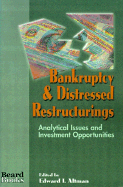|
|
|
|
||||||

|
Bankruptcy & Distressed Restructurings: Analytical Issues and Investment Opportunities
By Edward I. Altman (editor) 1999/02 - Beard Books 189312200X - Paperback - Reprint - 430 pp. US$34.95 Seventeen substantial papers presented at an innovative 1991 conference to study and discuss corporate distressed restructurings and bankruptcies, including bankruptcy costs and distressed firm values, investing and trading, and strategic issues. Publisher Comments In today's vulnerable and volatile business climate, corporate bankruptcy and chapter 11 reorganization is a common occurrence among U.S. corporations of all sizes and in all sectors. As a result, the market for distressed firms' debt and equity securities continues to capture the interest and imagination of the investment community. This book compiles the insights of more than 30 experts from both the practitioner and academic communities on a multitude of subjects including bankruptcy and liquidation costs, the determinants of successful Chapter 11 proceedings, competitor behavior related to distress, and investment opportunities in distressed and defaulted securities --- must reading for anyone involved in corporate finance, financial markets, economics, or law. Review by Henry Berry, Turnarounds and Workouts: Bankruptcy and Distressed Restructurings offers the trenchant observations of over 30 experts from leading financial firms and business schools, including Salomon Brothers, Merrill Lynch, the London Business School, Harvard Business School, and the Stern School of Business at New York University (NYU). The book’s content comes from collected papers from a March 1991 conference at NYU that was devoted to studying the relationships between bankruptcy and distressed restructurings. While an esoteric subject, it is made eminently readable under the capable editing of Edward Altman. Altman divides the subject matter into four main sections – restructuring, bankruptcy costs and company valuations, investing and trading in distressed firms, and strategic issues for both the firms and investors. Altman is also coauthor of the chapter “Firm Valuation and Corporate Leveraged Restructurings,” and he writes the closing chapter on trends in the field. Most of the chapters offer a combination of introductory and advanced material, and apply the material to resolving hypothetical and actual cases. For example, there is a chapter on highly-leveraged transaction (HLT) loans that reviews the rationale for this emerging market for both fixed-income and equity investors, compares the structure of HLT loans to that of other high-yield instruments, and suggests a valuation convention to compare yields and relative value. HLT loans are loans that are traded near par with little price differentiation for fundamental credit variables. The authors of this chapter, from the New York firm Salomon Brothers, take an introductory approach to this subject, but also presuppose a fairly developed knowledge of this financial area. The introductory approach is not so basic as to define or explain fixed-income, equity, high-yield instruments, and valuation, for instance. Many of the chapters utilize studies and statistics and sometimes refer to individual companies in applying the material toward actual conditions or cases. Two of the chapters present results of a survey of firms that underwent reorganization. The results show the differences and commonalities of such firms. Other chapters offer an empirical study and investigation of troubled companies and provide a context for the prospective investor who is weighing whether to become involved in a distressed situation. Still other chapters deal with the valuation of distressed companies and regulatory matters that should be considered before investing in one. Management, which is essential to the recovery of a distressed firm and a favorable return on investment, is another topic given full treatment in this book. The financial risks with regard to managing bankruptcies of or investments in distressed corporations are so high, the issues so complex and often cloudy, and the opportunities so inviting yet uncertain that the field attracts the best minds and top performers. With these collected papers, readers have access to the thinking of many experts on a range of central matters in this fascinating field. Edward I. Altman is internationally recognized in the field of corporate bankruptcy and credit risk analysis from awards he has received, positions he holds, and books he has written. He is the Max L. Heine Professor of Finance at NYU’s Stern School of Business. From Amazon.Com: Corporate bankruptcy and Chapter 11 reorganization is a common occurrence in U.S. corporations of all sizes, in all sectors. As a result, the investment community is looking at the market for distressed firms' debt and equity securities in a new light. This book shows readers bankruptcy and liquidation costs and their impact on corporate values and investment opportunities in distressed and defaulted securities. From Amazon.Com: This book is a collection of academic papers on the subject of corporate bankruptcy and distress. The writers present an excellent but somewhat repetitive body of information in a very passive manner. As such, the book is a real snore! So if you choose to read it, drink an extra large Starbucks coffee and bear down. I found reading it well worth the effort. Given the real human issues, hardships, brinkmanship, and huge volume of case work involved in bankruptcy and distress, the subject matter could have been presented in a much more entertaining manner.
|
|
|
|
home
| about us
| contact us
| related
sites |